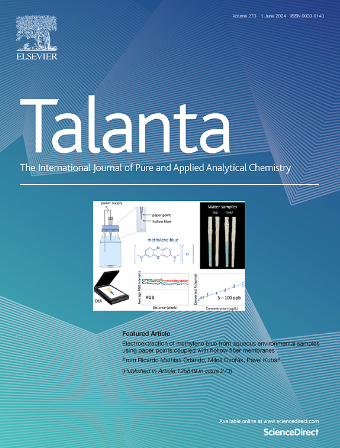LC biosensors (Bio-LC): new resonant sensors for direct detection of airborne viruses
IF 6.1
1区 化学
Q1 CHEMISTRY, ANALYTICAL
引用次数: 0
Abstract
Viruses suspended in the air are key in the transmission of infectious diseases. We present a label-free selective system capable of detecting in situ airborne viruses in ambient air, employing resonant LC (Inductor-Capacitator) circuits. As proof of principle, M13 bacteriophages were nebulized and monitored with this sensor. The selective recognition of viruses by the copper immune-functionalized inductor of an LC circuit resulted in shifts of its resonant frequency proportional to the virus ambient concentration. The selectivity of this resonator is due to the employed bioreceptor. So, the lowest ambient concentration of airborne M13 bacteriophage that can be selectively detected is 3 × 105 pfu L−1. This biosensing approach opens appealing perspectives for controlling the transmission of infectious diseases.

液相色谱生物传感器(Bio-LC):直接检测空气传播病毒的新型共振传感器
悬浮在空气中的病毒是传染病传播的关键。我们提出了一种无标记选择系统,能够检测环境空气中的原位空气传播病毒,采用谐振LC(电感-电容)电路。作为原理证明,M13噬菌体用该传感器雾化和监测。LC电路的铜免疫功能化电感对病毒的选择性识别导致其谐振频率与病毒环境浓度成正比的变化。这种谐振器的选择性是由于所采用的生物受体。因此,空气中可选择性检测到的M13噬菌体的最低环境浓度为3 × 105 pfu L−1。这种生物传感方法为控制传染病的传播开辟了诱人的前景。
本文章由计算机程序翻译,如有差异,请以英文原文为准。
求助全文
约1分钟内获得全文
求助全文
来源期刊

Talanta
化学-分析化学
CiteScore
12.30
自引率
4.90%
发文量
861
审稿时长
29 days
期刊介绍:
Talanta provides a forum for the publication of original research papers, short communications, and critical reviews in all branches of pure and applied analytical chemistry. Papers are evaluated based on established guidelines, including the fundamental nature of the study, scientific novelty, substantial improvement or advantage over existing technology or methods, and demonstrated analytical applicability. Original research papers on fundamental studies, and on novel sensor and instrumentation developments, are encouraged. Novel or improved applications in areas such as clinical and biological chemistry, environmental analysis, geochemistry, materials science and engineering, and analytical platforms for omics development are welcome.
Analytical performance of methods should be determined, including interference and matrix effects, and methods should be validated by comparison with a standard method, or analysis of a certified reference material. Simple spiking recoveries may not be sufficient. The developed method should especially comprise information on selectivity, sensitivity, detection limits, accuracy, and reliability. However, applying official validation or robustness studies to a routine method or technique does not necessarily constitute novelty. Proper statistical treatment of the data should be provided. Relevant literature should be cited, including related publications by the authors, and authors should discuss how their proposed methodology compares with previously reported methods.
 求助内容:
求助内容: 应助结果提醒方式:
应助结果提醒方式:


